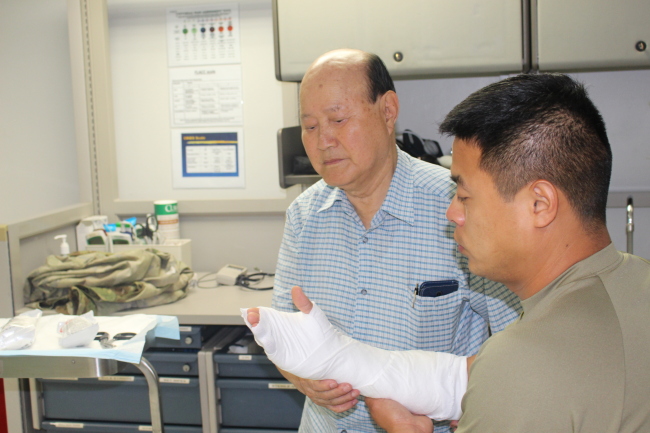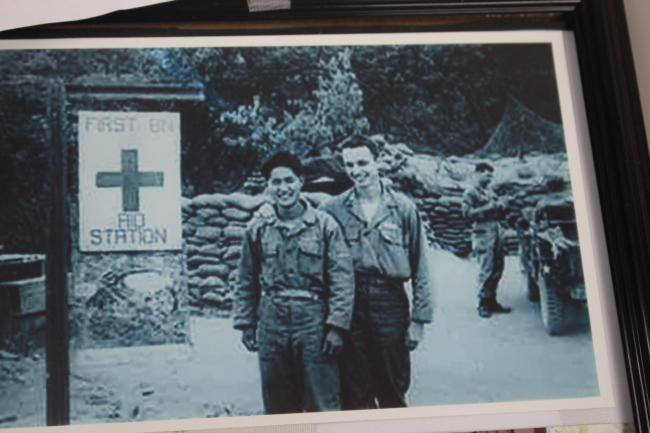[Weekender] Original KATUSA soldier shares memories of war, pride of service
By Yoon Min-sikPublished : July 8, 2016 - 17:12
Yu Yong-bong has not gone hiking for decades.
The haunting memories of fighting in the mountains have kept him away from the trails.
The 84-year-old former member of the U.S. Army 7th Infantry Division was one of the original 313 Korea Augmentation to the U.S. Army soldiers recruited in the first few months of the 1950-53 Korean War.
He was among South Korean and U.S. soldiers who marched to the Yalu River on Nov. 20, 1950.
“We grabbed a chunk of ice and ate it because we were so happy. We thought it was over,” said Yu, reminiscing upon the joy that his 18-year-old self had felt as the war seemed to inch toward the end.
The haunting memories of fighting in the mountains have kept him away from the trails.
The 84-year-old former member of the U.S. Army 7th Infantry Division was one of the original 313 Korea Augmentation to the U.S. Army soldiers recruited in the first few months of the 1950-53 Korean War.
He was among South Korean and U.S. soldiers who marched to the Yalu River on Nov. 20, 1950.
“We grabbed a chunk of ice and ate it because we were so happy. We thought it was over,” said Yu, reminiscing upon the joy that his 18-year-old self had felt as the war seemed to inch toward the end.

Little did he know that a swarm of Chinese Communist Forces and North Korean soldiers were preparing to strike.
Three days later, Yu’s division found themselves cornered in the mountains, desperately fighting to escape.
“After two weeks of fierce fighting, the U.S. 1st Marine Division and us were able to break through the siege of the Chinese forces. Thousands were killed and many more were injured. If it weren’t for the help of the citizens who let us use the cable car used by miners, I would not be alive today,” he said.
Sixty-six years later, memories of the bloody escape still keep Yu from going near mountains.
For Yu, the military was not his first choice.
On Aug. 16, 1950, the then-high school junior was on his way to school in Daegu when a policeman got hold of him and urged him to join the forces. He never got a chance to say goodbye to his family, or even visit them, as the raging war demanded more soldiers.
Ushered onto a ship headed for Japan, he and other recruits were treated to what seemed to be a gourmet meal on board.
“We never had enough to eat back then, so the sight of it was just magnificent,” Yu said.
“We also tasted coffee for the first time. Some guys would get greedy and just pour sugar all over it, so it would be half liquid and half sugar. Pretty soon, the sugar would be rationed to two spoons per cup.”
But the teenager would soon learn that seasickness was a formidable foe, as he wound up hurling most of his meal overboard for much of the three-day trip.
In Japan, Yu was assigned as a medic to the U.S. Army 7th Division, 17th Infantry Regiment, 1st Battalion Aid Station.
It was his English skills that made him one of the first KATUSA soldiers.
“My older brother would tell me to study English, because it would come in handy with the U.S. military working with the (Korean) government,” he said. The war would eventually claim the life of that brother, while Yu’s other older brother was injured.
The new soldiers were then deployed to the Battle of Incheon, codenamed Operation Chromite.
Yu said that the KATUSA soldiers helped U.S. troops who were not accustomed to navigating in the foreign land. Moreover, his easygoing personality and devotion to work helped him bridge the relationship between Koreans and Americans.
“U.S. soldiers used to call Koreans, ‘Gook.’ But I would advise them not to use that word because it is derogatory toward Koreans,” he said.
One particular relationship that stood out for him was with the U.S. medical officer Edward Guy, with whom he was paired.
Three days later, Yu’s division found themselves cornered in the mountains, desperately fighting to escape.
“After two weeks of fierce fighting, the U.S. 1st Marine Division and us were able to break through the siege of the Chinese forces. Thousands were killed and many more were injured. If it weren’t for the help of the citizens who let us use the cable car used by miners, I would not be alive today,” he said.
Sixty-six years later, memories of the bloody escape still keep Yu from going near mountains.
For Yu, the military was not his first choice.
On Aug. 16, 1950, the then-high school junior was on his way to school in Daegu when a policeman got hold of him and urged him to join the forces. He never got a chance to say goodbye to his family, or even visit them, as the raging war demanded more soldiers.
Ushered onto a ship headed for Japan, he and other recruits were treated to what seemed to be a gourmet meal on board.
“We never had enough to eat back then, so the sight of it was just magnificent,” Yu said.
“We also tasted coffee for the first time. Some guys would get greedy and just pour sugar all over it, so it would be half liquid and half sugar. Pretty soon, the sugar would be rationed to two spoons per cup.”
But the teenager would soon learn that seasickness was a formidable foe, as he wound up hurling most of his meal overboard for much of the three-day trip.
In Japan, Yu was assigned as a medic to the U.S. Army 7th Division, 17th Infantry Regiment, 1st Battalion Aid Station.
It was his English skills that made him one of the first KATUSA soldiers.
“My older brother would tell me to study English, because it would come in handy with the U.S. military working with the (Korean) government,” he said. The war would eventually claim the life of that brother, while Yu’s other older brother was injured.
The new soldiers were then deployed to the Battle of Incheon, codenamed Operation Chromite.
Yu said that the KATUSA soldiers helped U.S. troops who were not accustomed to navigating in the foreign land. Moreover, his easygoing personality and devotion to work helped him bridge the relationship between Koreans and Americans.
“U.S. soldiers used to call Koreans, ‘Gook.’ But I would advise them not to use that word because it is derogatory toward Koreans,” he said.
One particular relationship that stood out for him was with the U.S. medical officer Edward Guy, with whom he was paired.

“There were these Korean workers who used to work for the Army. One of them was shot in the leg and was brought to us. He moaned ‘Aigoo! Aigoo!’ which in Korean means ouch. Guy was surprised and said ‘Don’t go!’ So I explained that it wasn’t what he meant,” he said.
In 2011, the two comrades were reunited after nearly 60 years.
This was not the only tearful reunion that Yu has experienced.
On Oct. 26, 1950, Yu and Guy were in Daegu while being transported.
“It was around 7 a.m. We were standing in the street, when I noticed two women standing near a shop. It was a gut-wrenching moment when I realized it was my mother,” Yu said.
From the time her youngest son failed to make it home in August, Yu’s mother had visited nearby temples every day, praying for her son’s safe return home.
“I walked toward her and said, ‘Mother, it’s me.’ First she was taken back by a familiar voice coming out of a fully-armed soldier. I took my helmet off, she grabbed me and said, ‘My Young-bong is finally here!”
“It was a miracle that I was even able to spot her in that fleeting moment.”
Yu finished his service in 1954, but his connection with the U.S. Army was not over. In 1958, he returned to the 543rd General Dispensary, now known as Camp Walker’s wood Army Medical Clinic, where he worked until his retirement in 2004.
Even after retirement, he applied as a Red Cross volunteer to continue working at the clinic. He can still be found there today, applying bandages and caring for youthful soldiers who he describes as “like his own grandchildren.”
“I’m grateful. I’m grateful for what the U.S. Army did for my life, and to my country. In over 40 years of service, I never took a day off, because of that,” he said.
Yu said his devotion to working for the South Korean and U.S. military is a great source of pride.
“Even now, the South Korea-U.S. alliance is very important. The U.S. military plays an integral role in our country’s defense and the role of KATUSA soldiers -- aiding the two sides’ coordination -- is that much important,” he said.
By Yoon Min-sik (minsikyoon@heraldcorp.com)
In 2011, the two comrades were reunited after nearly 60 years.
This was not the only tearful reunion that Yu has experienced.
On Oct. 26, 1950, Yu and Guy were in Daegu while being transported.
“It was around 7 a.m. We were standing in the street, when I noticed two women standing near a shop. It was a gut-wrenching moment when I realized it was my mother,” Yu said.
From the time her youngest son failed to make it home in August, Yu’s mother had visited nearby temples every day, praying for her son’s safe return home.
“I walked toward her and said, ‘Mother, it’s me.’ First she was taken back by a familiar voice coming out of a fully-armed soldier. I took my helmet off, she grabbed me and said, ‘My Young-bong is finally here!”
“It was a miracle that I was even able to spot her in that fleeting moment.”
Yu finished his service in 1954, but his connection with the U.S. Army was not over. In 1958, he returned to the 543rd General Dispensary, now known as Camp Walker’s wood Army Medical Clinic, where he worked until his retirement in 2004.
Even after retirement, he applied as a Red Cross volunteer to continue working at the clinic. He can still be found there today, applying bandages and caring for youthful soldiers who he describes as “like his own grandchildren.”
“I’m grateful. I’m grateful for what the U.S. Army did for my life, and to my country. In over 40 years of service, I never took a day off, because of that,” he said.
Yu said his devotion to working for the South Korean and U.S. military is a great source of pride.
“Even now, the South Korea-U.S. alliance is very important. The U.S. military plays an integral role in our country’s defense and the role of KATUSA soldiers -- aiding the two sides’ coordination -- is that much important,” he said.
By Yoon Min-sik (minsikyoon@heraldcorp.com)









![[Hello India] Hyundai Motor vows to boost 'clean mobility' in India](http://res.heraldm.com/phpwas/restmb_idxmake.php?idx=644&simg=/content/image/2024/04/25/20240425050672_0.jpg&u=)









